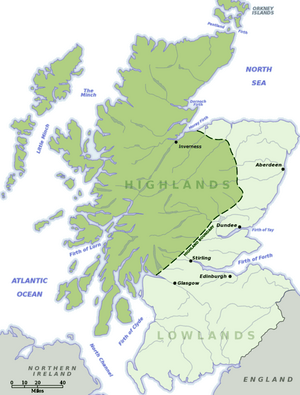Cawdor (Roman fort) facts for kids

Easter Glacantray, an alleged Roman fort), is located near the small village of Cawdor (15 miles east of Inverness). It is alleged to be a Roman fort although there is a lack of archaeological evidence to support this claim.
Discovery
In 1984, the site of an alleged Roman fort was identified at Easter Galcantray, south west of Cawdor, by aerial photography.
The site was excavated between 1985 and 1990 with a single fragment of pottery being discovered which was assumed to be Roman because it looked similar to a fragment found at Inchtuthil legionary fortress. Other features alleged to be Roman, are just as likely to belong to structures built in other periods. The most recent analysis of the site can be found in.
Jones (1986a) interpreted the main structural phase within the [Cawdor] site’s history as potential evidence for the presence of a Roman military work. This assumption was based on a number of salient factors. These include: the rectilinear form of the enclosure ditch, with its V-shaped profile; Postholes were uncovered which Jones assumed belonged to a gate, although this was an assumption that four postholes made a gate – these postholes are not evenly spread and are unlikely to have all been part of the same structure. Jones also noted the presence of possible contemporary rectilinear timber buildings, which he thought were reminiscent in both size and form to barrack blocks, although the reality is that Jones was, again, 'joining the dots' and assuming that the postholes, which were not equally spread, are from the same structure; and finally, the dating evidence. This, based on the one sigma calibrated range, suggests the slighting of the site during the late first century AD, which would correspond to the governorship of Agricola, or possibly his unknown successor.
If confirmed, it would be the most northerly known Roman fort in the British Isles, but this is highly unlikely given that the next nearest fort is Stracathro, over 100 miles away. It is not confirmed that Agricola reached this far north, despite misleading discoveries at Portmahomack and Tarradale on the northern shores of the Beauly Firth, but archaeologists who specialise in the Roman period have been consistently reticent in confirming Jones' interpretation of the site.
More research required
Easter Galcantray is near Inverness, and has never seriously been considered the northernmost place of Roman conquest, despite what amateur historians and conspiracy theorists say.
Historically it is known that in the summer of 83AD Agricola defeated the massed armies of the Caledonians, led by Calgacus, at the Battle of Mons Graupius. With victory, Agricola extracted hostages from the Caledonian tribes and instructed his fleet to sail around the north coast confirming to the Romans the province of Britannia was an island.
Agricola then may have marched his army to the northern coast of Britain, and reached the Inverness area, in the vicinity of the Easter Galcantray (Cawdor) Fort. In 1985, it was recorded that a "small piece of Roman coarse ware“ was found with burnt material at the bottom of a ditch at the site but subsequent studies of the pottery identified it as medieval.
Similarly, although radiocarbon tests of material recovered from the site gave possible dates of construction during the first century, its interpretation remains problematic because the site was occupied and abandoned quite quickly leaving no other evidence. Furthermore, there has been no academic consensus over two centuries regarding the actual location for the battle of Mons Graupius. For example, William Roy (1793), Gabriel Jacques Surenne (1823), Archibald Watt and C. Michael Hogan believe it was fought further south on the coast near the Roman camps of Raedykes or Glenmailen. Whereas Vittorio di Martino (author of "Roman Ireland", about a possible Roman expedition to Ireland) believes the Roman victory happened in an area southwest of Cawdor.
Images for kids
-
Cawdor Roman Fort is located near Inverness. It was considered the northernmost place of Roman conquest and presence in Britannia, until the recent discovery of Roman military presence at Tarradale and Portmahomack.
See also
 In Spanish: Cawdor (fuerte romano) para niños
In Spanish: Cawdor (fuerte romano) para niños



